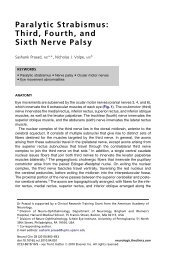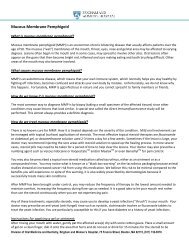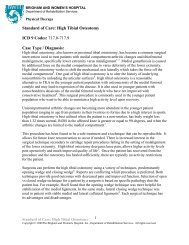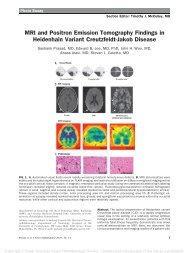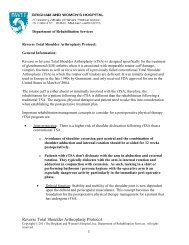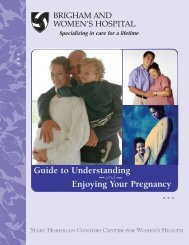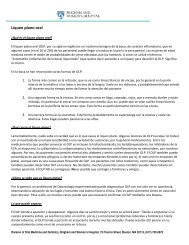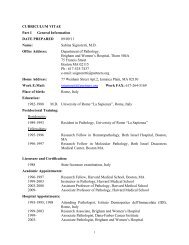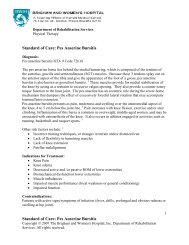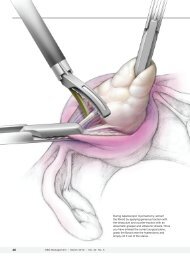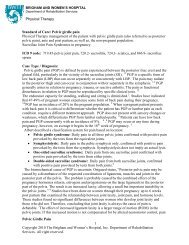Reverse TSA with LDTT Protocol - Brigham and Women's Hospital
Reverse TSA with LDTT Protocol - Brigham and Women's Hospital
Reverse TSA with LDTT Protocol - Brigham and Women's Hospital
Create successful ePaper yourself
Turn your PDF publications into a flip-book with our unique Google optimized e-Paper software.
Department of Rehabilitation Services<br />
stabilizer creating an external rotation moment around the r<strong>TSA</strong> components. This conversion to<br />
a humeral head stabilizer <strong>and</strong> external rotator is important as it now allows the joint to function<br />
more efficiently as it compensates for the actions of the deficient teres minor. The biomechanics<br />
of the postoperative shoulder allow for more effective action of the deltoid, which is important<br />
during various daily activities that incorporate elevation <strong>and</strong> abduction movements.<br />
The rotator cuff is absent <strong>with</strong> the r<strong>TSA</strong> <strong>and</strong> <strong>LDTT</strong>; therefore, the rehabilitation for a patient<br />
following the r<strong>TSA</strong> <strong>and</strong> <strong>LDTT</strong> is different than the rehabilitation following a traditional <strong>TSA</strong>.<br />
The surgeon, physical therapist <strong>and</strong> patient need to take this into consideration when establishing<br />
the postoperative treatment plan. Important rehabilitation management concepts to consider for a<br />
postoperative physical therapy r<strong>TSA</strong> <strong>and</strong> <strong>LDTT</strong> program are:<br />
• Joint protection: There is a higher risk of shoulder dislocation following r<strong>TSA</strong> <strong>and</strong><br />
<strong>LDTT</strong> when compared to a conventional <strong>TSA</strong>.<br />
o Patients following a r<strong>TSA</strong> <strong>with</strong> <strong>LDTT</strong> do not dislocate <strong>with</strong> the arm in abduction<br />
<strong>and</strong> external rotation. They will typically dislocate <strong>with</strong> the arm in internal<br />
rotation <strong>and</strong> adduction in conjunction <strong>with</strong> extension. For example, tucking in a<br />
shirt or performing bathroom / personnel hygiene <strong>with</strong> the operative arm is a<br />
dangerous activity particularly in the immediate peri-operative phase.<br />
o Avoidance of shoulder extension beyond neutral <strong>with</strong> the combination of shoulder<br />
adduction <strong>and</strong> internal rotation for a minimum of 12 weeks postoperatively.<br />
o It is important to avoid over stretching or putting excessive tension on the healing<br />
transferred latissimus dorsi tendon. No aggressive internal rotation, flexion, or<br />
adduction is advised.<br />
• Deltoid function: Stability <strong>and</strong> mobility of the shoulder joint is now dependent upon the<br />
deltoid <strong>and</strong> periscapular musculature. This concept becomes the foundation for the<br />
postoperative physical therapy management for a patient following r<strong>TSA</strong> <strong>with</strong> <strong>LDTT</strong>.<br />
• Function: As <strong>with</strong> a conventional <strong>TSA</strong>, maximize overall upper extremity function,<br />
while respecting soft tissue constraints.<br />
• ROM: Expectation for range of motion gains should be set on a case-by-case<br />
basis depending upon underlying pathology. Normal/full active range of motion<br />
of the shoulder joint following r<strong>TSA</strong> <strong>with</strong> a <strong>LDTT</strong> is not expected.<br />
<strong>Reverse</strong> Total Shoulder Arthroplasty <strong>with</strong> Latissimus dorsi tendon transfer <strong>Protocol</strong><br />
Copyright © 2008 The <strong>Brigham</strong> <strong>and</strong> <strong>Women's</strong> <strong>Hospital</strong>, Inc. Department of Rehabilitation Services. All rights<br />
reserved.<br />
2



